
The Sustainable Development Goals (SDGs), also known as the Global Goals, were adopted by the United Nations in 2015 as a universal call to action to end poverty, protect the planet, and ensure that by 2030 all people enjoy peace and prosperity.
The 17 SDGs are integrated—they recognize that action in one area will affect outcomes in others, and that development must balance social, economic and environmental sustainability.
Countries have committed to prioritize progress for those who're furthest behind. The SDGs are designed to end poverty, hunger, AIDS, and discrimination against women and girls.
The creativity, knowhow, technology and financial resources from all of society is necessary to achieve the SDGs in every context.
1
Eradicating poverty in all its forms remains one of the greatest challenges facing humanity. While the number of people living in extreme poverty dropped by more than half between 1990 and 2015, too many are still struggling for the most basic human needs.
As of 2015, about 736 million people still lived on less than US$1.90 a day; many lack food, clean drinking water and sanitation. Rapid growth in countries such as China and India has lifted millions out of poverty, but progress has been uneven. Women are more likely to be poor than men because they have less paid work, education, and own less property.
Progress has also been limited in other regions, such as South Asia and sub-Saharan Africa, which account for 80 percent of those living in extreme poverty. New threats brought on by climate change, conflict and food insecurity, mean even more work is needed to bring people out of poverty.
The SDGs are a bold commitment to finish what we started, and end poverty in all forms and dimensions by 2030. This involves targeting the most vulnerable, increasing basic resources and services, and supporting communities affected by conflict and climate-related disasters.

736 million people still live in extreme poverty.
10 percent of the world’s population live in extreme poverty, down from 36 percent in 1990.
Some 1.3 billion people live in multidimensional poverty.
Half of all people living in poverty are under 18.
One person in every 10 is extremely poor.







The number of undernourished people has dropped by almost half in the past two decades because of rapid economic growth and increased agricultural productivity. Many developing countries that used to suffer from famine and hunger can now meet their nutritional needs. Central and East Asia, Latin America and the Caribbean have all made huge progress in eradicating extreme hunger.
Unfortunately, extreme hunger and malnutrition remain a huge barrier to development in many countries. There are 821 million people estimated to be chronically undernourished as of 2017, often as a direct consequence of environmental degradation, drought and biodiversity loss. Over 90 million children under five are dangerously underweight. Undernourishment and severe food insecurity appear to be increasing in almost all regions of Africa, as well as in South America.
The SDGs aim to end all forms of hunger and malnutrition by 2030, making sure all people–especially children–have sufficient and nutritious food all year. This involves promoting sustainable agricultural, supporting small-scale farmers and equal access to land, technology and markets. It also requires international cooperation to ensure investment in infrastructure and technology to improve agricultural productivity.

The number of undernourished people reached 821 million in 2017.
In 2017 Asia accounted for nearly two thirds, 63 percent, of the world’s hungry.
Nearly 151 million children under five, 22 percent, were still stunted in 2017.
More than 1 in 8 adults is obese.
1 in 3 women of reproductive age is anemic.
26 percent of workers are employed in agriculture.







We have made great progress against several leading causes of death and disease. Life expectancy has increased dramatically; infant and maternal mortality rates have declined, we’ve turned the tide on HIV and malaria deaths have halved.
Good health is essential to sustainable development and the 2030 Agenda reflects the complexity and interconnectedness of the two. It takes into account widening economic and social inequalities, rapid urbanization, threats to the climate and the environment, the continuing burden of HIV and other infectious diseases, and emerging challenges such as noncommunicable diseases. Universal health coverage will be integral to achieving SDG 3, ending poverty and reducing inequalities. Emerging global health priorities not explicitly included in the SDGs, including antimicrobial resistance, also demand action.
But the world is off-track to achieve the health-related SDGs. Progress has been uneven, both between and within countries. There’s a 31-year gap between the countries with the shortest and longest life expectancies. And while some countries have made impressive gains, national averages hide that many are being left behind. Multisectoral, rights-based and gender-sensitive approaches are essential to address inequalities and to build good health for all.

At least 400 million people have no basic healthcare, and 40 percent lack social protection.
More than 1.6 billion people live in fragile settings where protracted crises, combined with weak national capacity to deliver basic health services, present a significant challenge to global health.
By the end of 2017, 21.7 million people living with HIV were receiving antiretroviral therapy. Yet more than 15 million people are still waiting for treatment.
Every 2 seconds someone aged 30 to 70 years dies prematurely from noncommunicable diseases - cardiovascular disease, chronic respiratory disease, diabetes or cancer.
7 million people die every year from exposure to fine particles in polluted air.
More than one of every three women have experienced either physical or sexual violence at some point in their life resulting in both short- and long-term consequences for their physical, mental, and sexual and reproductive health.







Since 2000, there has been enormous progress in achieving the target of universal primary education. The total enrollment rate in developing regions reached 91 percent in 2015, and the worldwide number of children out of school has dropped by almost half. There has also been a dramatic increase in literacy rates, and many more girls are in school than ever before. These are all remarkable successes.
Progress has also been tough in some developing regions due to high levels of poverty, armed conflicts and other emergencies. In Western Asia and North Africa, ongoing armed conflict has seen an increase in the number of children out of school. This is a worrying trend. While Sub-Saharan Africa made the greatest progress in primary school enrollment among all developing regions – from 52 percent in 1990, up to 78 percent in 2012 – large disparities still remain. Children from the poorest households are up to four times more likely to be out of school than those of the richest households. Disparities between rural and urban areas also remain high.
Achieving inclusive and quality education for all reaffirms the belief that education is one of the most powerful and proven vehicles for sustainable development. This goal ensures that all girls and boys complete free primary and secondary schooling by 2030. It also aims to provide equal access to affordable vocational training, to eliminate gender and wealth disparities, and achieve universal access to a quality higher education.